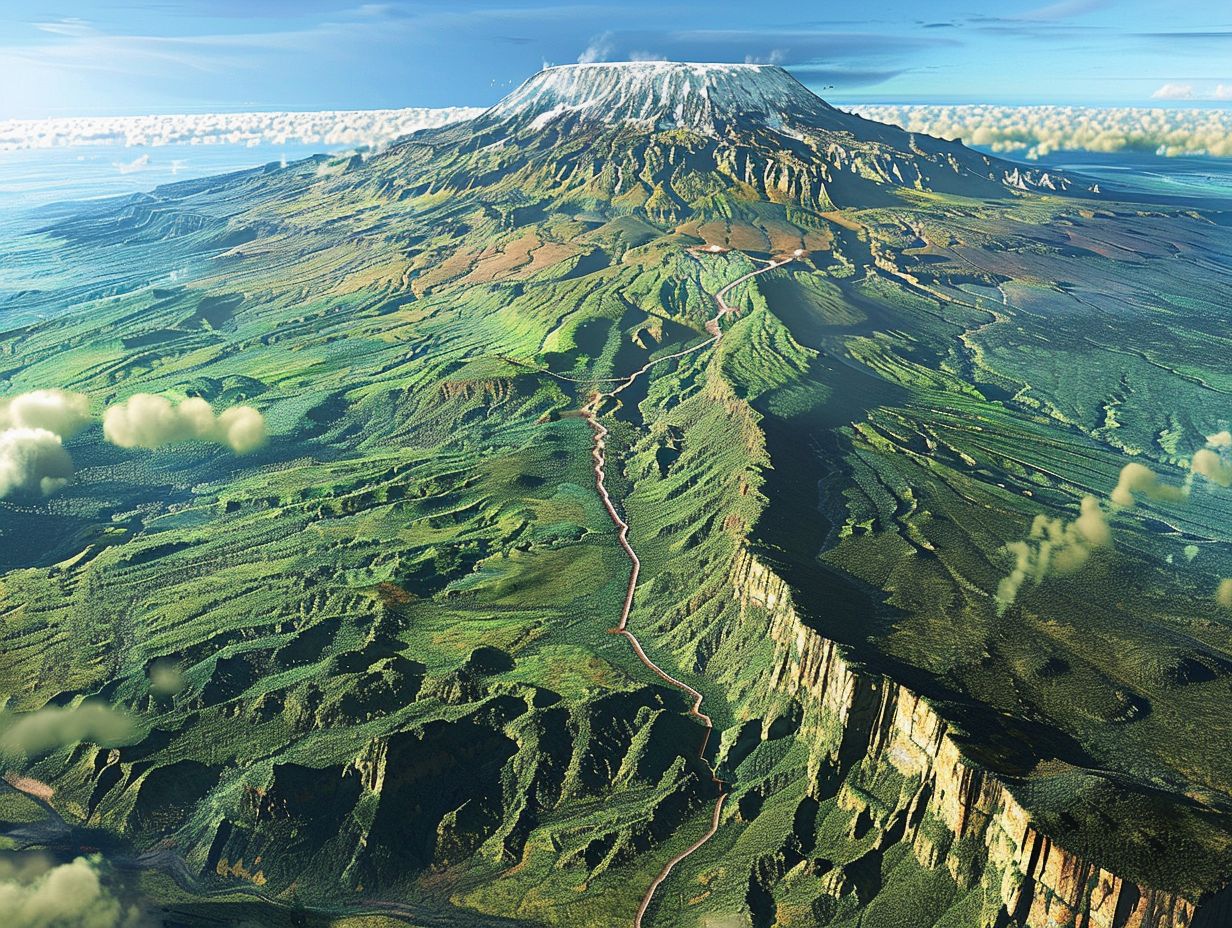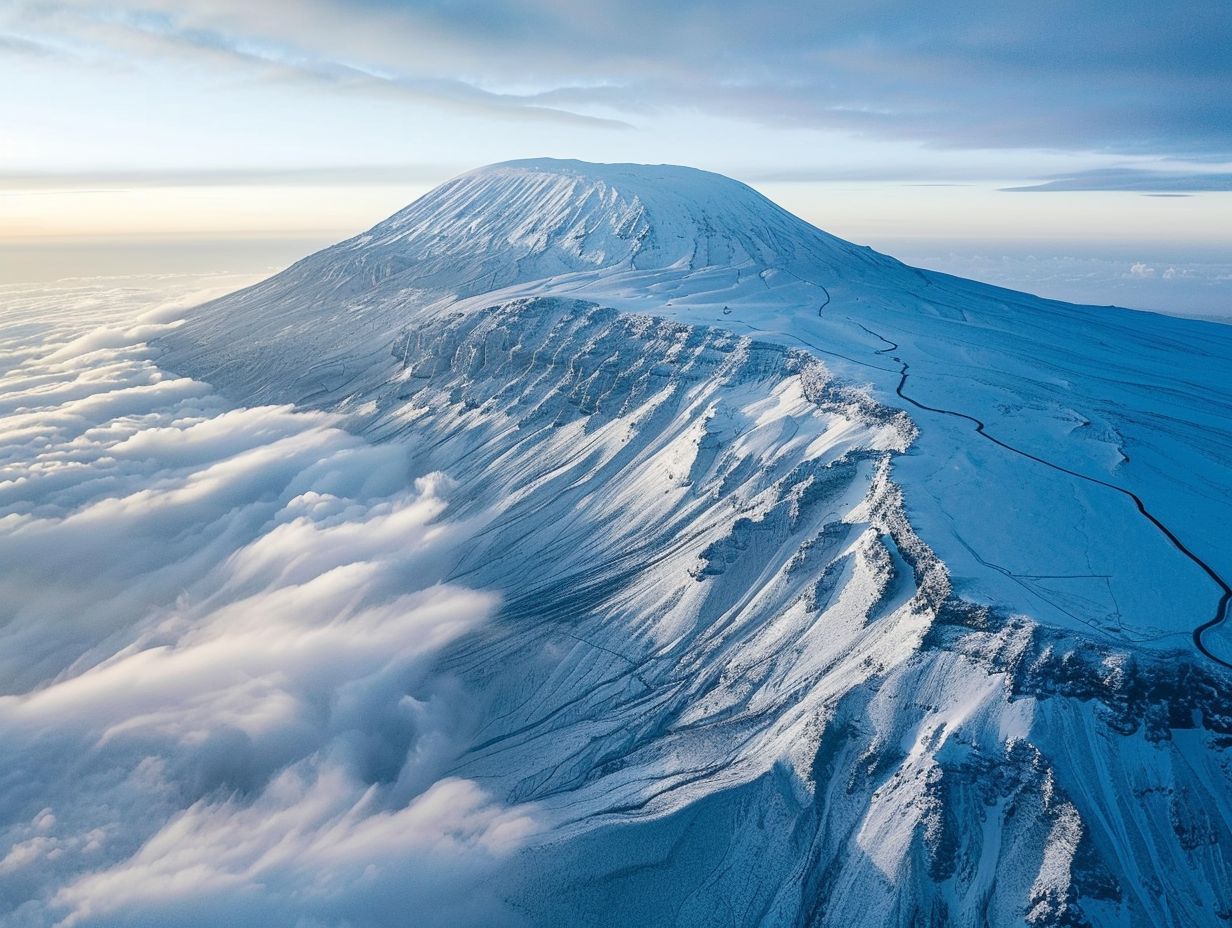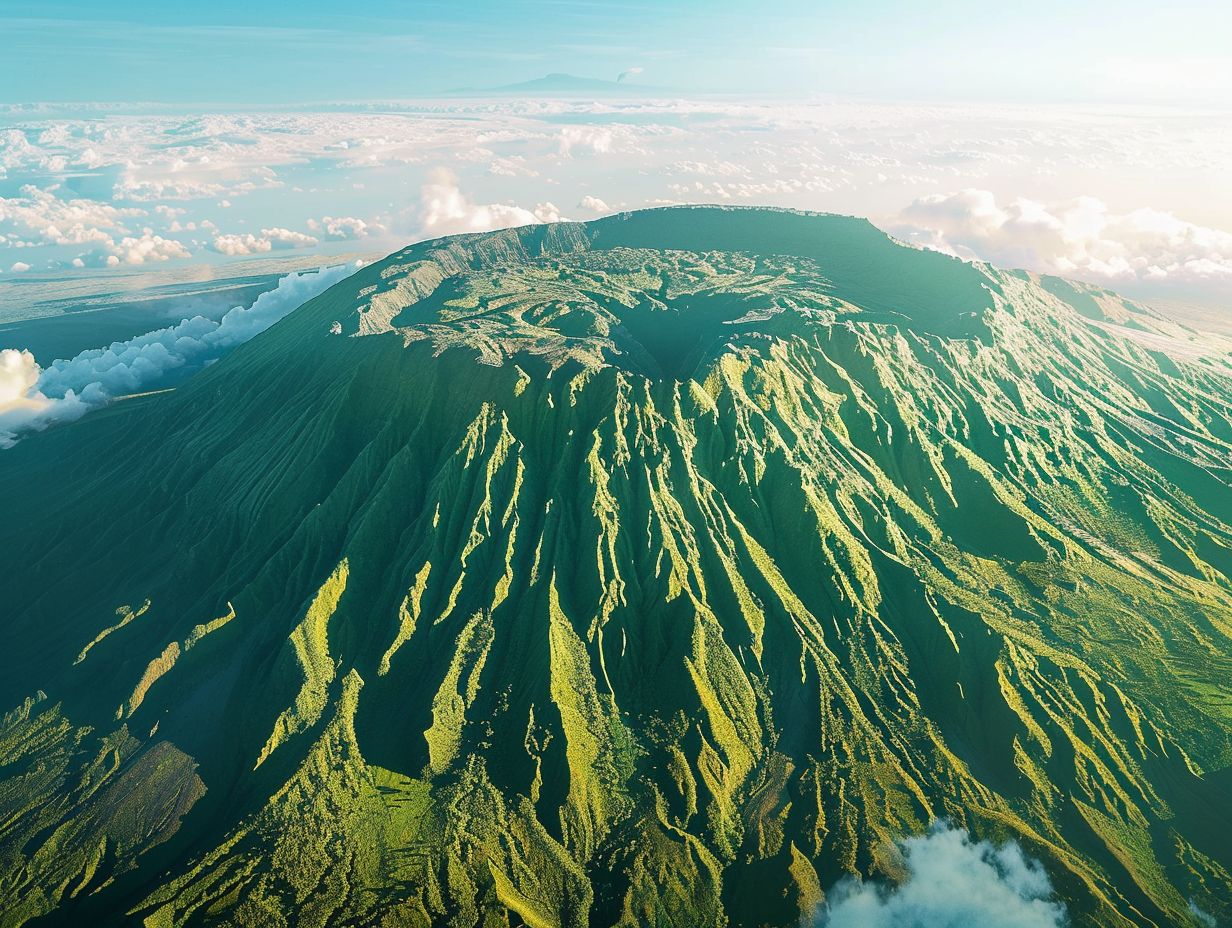
Located in Tanzania, Mount Kilimanjaro is a popular destination for hikers and adventurers from around the world. With several different routes to choose from, selecting the right one can be a daunting task.
In this guide, we will take a closer look at the longest route on Kilimanjaro, the Northern Circuit. We will discuss why this route is a popular choice, what makes it the longest, what to expect along the way, and provide tips for a successful hike.
So lace up your boots and get ready to conquer Kilimanjaro on the Northern Circuit!
Key Takeaways:

- The Northern Circuit is the longest route to climb Mount Kilimanjaro, spanning over 8 days of trekking.
- Its length allows for better acclimatization and higher chances of summiting.
- To successfully complete the Northern Circuit, proper physical preparation, packing list, and altitude sickness prevention are crucial.
Choosing the Right Route for Kilimanjaro
Selecting the appropriate route when climbing Kilimanjaro is crucial to the success and enjoyment of your expedition. With various options like the Lemosho, Machame, Marangu, Rongai, Shira, and Umbwe routes, each offering a unique experience for climbers, understanding the differences is essential.
Factors to Consider when Choosing a Route
When deciding on a Kilimanjaro route, factors like summit success rates, wildlife encounters, hut accommodation availability, terrain variations, and scenic beauty play a crucial role in determining the most suitable path for your ascent.
Summit success rates are impacted by the route’s difficulty level and acclimatization opportunities. Some routes, such as the Machame and Lemosho, offer better acclimatization chances, enhancing your chances of reaching the summit.
Wildlife sightings are often more frequent on the Rongai route, known for its unique wildlife and quieter trails. This route provides a chance to spot unique species like the Colobus monkeys and various bird species, adding an exciting element to your trek.
When considering hut accommodation, routes like Marangu have hut options, providing sheltered accommodations compared to camping. Camping routes like the Northern Circuit offer a more immersive experience under the stars.
The terrain varies across routes, from rocky paths on the Machame to more gradual slopes on the Marangu. Understanding the terrain can help you choose a route that aligns with your hiking preferences and fitness level.
Scenic landscapes differ greatly, with the Western Breach route offering dramatic lava formations and the Umbwe route providing secluded forests and breathtaking views. Choosing a route with landscapes that resonate with you can enhance your overall experience.
Overview of the Kilimanjaro Routes
The Kilimanjaro routes offer a diverse range of experiences, from the lush rainforests of the Lemosho route to the rugged terrains of the Umbwe route. Each route has its own unique charm and challenges, making it essential to understand their descriptions, assessments, and profiles before embarking on your journey.
For trekkers seeking a gradual ascent with breathtaking scenery, the Machame route, known as the ‘Whiskey Route,’ winds through a variety of landscapes, from dense forests to expansive moorlands, finally reaching the summit via the Barafu Camp.
Alternatively, the Marangu route, dubbed the ‘Coca-Cola Route,’ offers a more direct path with hut accommodations along the way. This route is ideal for novice climbers or those preferring more comfort during their expedition.
The Longest Route: Northern Circuit

Embark on the remarkable journey of the Northern Circuit, the longest route on Kilimanjaro that takes you through the summit circuit, offering breathtaking views of the Kibo crater and the thrilling ascent of the Western Breach.
Why choose the Northern Circuit?
Opting for the Northern Circuit route on Kilimanjaro provides unparalleled opportunities for acclimatisation, wildlife sightings, and captivating scenery. It offers a less crowded and more immersive experience for climbers seeking a unique adventure.
The Northern Circuit route stands out due to its gradual ascent profile which allows climbers more time to acclimatize, reducing the risk of altitude-related illnesses. This route, spanning around 9-10 days, offers a slower pace, enhancing the climber’s chances of successfully conquering the peak.
This route is renowned for its abundant wildlife encounters. As you traverse through different ecological zones, you may spot various species like elephants, buffaloes, and even rare birds amidst the stunning surroundings.
The picturesque landscapes along the Northern Circuit are truly mesmerizing. From the lush rainforests at lower altitudes to the rugged alpine desert and expansive glaciers at higher elevations, climbers are treated to a diverse array of environments that make the journey memorable.
What makes the Northern Circuit the longest route?
The Northern Circuit’s length is attributed to its comprehensive coverage of the mountain’s northern slopes, providing climbers with an extended trekking experience and a gradual ascent towards the summit, allowing for better acclimatisation and enjoyment.
The Northern Circuit’s route traverses diverse landscapes, from lush forests to alpine meadows, offering climbers a scenic journey unlike any other route on Kilimanjaro.
This variety in terrain not only adds to the overall adventure but also contributes to the overall experience of climbers by providing them with ever-changing landscapes to explore and enjoy.
The longer duration of the Northern Circuit allows climbers to acclimatize more effectively, reducing the risk of altitude sickness and increasing the chances of reaching the summit successfully.
Encompassing such a vast array of ecosystems and offering a slower, more gradual ascent makes the Northern Circuit a popular choice for climbers seeking a more immersive and rewarding Kilimanjaro experience.
What to Expect on the Northern Circuit
Embark on a detailed exploration of what awaits you on the Northern Circuit of Kilimanjaro, from the meticulously planned day-by-day itinerary to the awe-inspiring scenery and captivating highlights that define this extraordinary route.
Day-by-Day Itinerary
The day-by-day itinerary of the Northern Circuit offers a well-paced journey for climbers, allowing ample time for acclimatisation, overnight stays at various campsites, and gradual ascents to higher altitudes, ensuring a safe and enjoyable experience.
On the first day, climbers start their trek from the lush rainforest, gaining a moderate altitude. They then reach the Mandara Hut, the first campsite. Day two brings a steep ascent through montane forests to Horombo Hut for acclimatization.
Moving to the third day, climbers hike to the scenic Kibo Hut, preparing for the summit attempt. Day four involves a demanding climb to Gilman’s Point and then to Uhuru Peak, the highest point in Africa, before descending to the final camp at Mweka Hut, marking the end of the trek.
Scenery and Highlights
The Northern Circuit is renowned for its stunning scenery, diverse wildlife sightings, and unique terrain features that create a memorable and visually captivating experience for climbers. From lush forests to alpine deserts, this route offers a tapestry of natural wonders.
As you traverse the Northern Circuit, you will be enchanted by the snow-capped peaks of Mount Kilimanjaro, Africa’s highest mountain, standing majestically against the backdrop of the endless savannah plains. The route also takes you through the mesmerizing Rift Valley, with its striking escarpments and rich biodiversity.
Keep your eyes peeled for the magnificent herds of African elephants wandering freely in their natural habitat, along with graceful giraffes grazing peacefully under the acacia trees. The Northern Circuit truly provides a front-row seat to the untamed beauty of the African wilderness.
Tips for a Successful Kilimanjaro Hike on the Northern Circuit

Prepare for a triumphant ascent on the Northern Circuit of Kilimanjaro with essential tips for physical readiness, altitude sickness prevention strategies, and a comprehensive packing list to ensure a successful and safe hiking experience.
Physical Preparation
Physical preparation is vital for climbers undertaking the Northern Circuit, as the high altitudes and risk of Acute Mountain Sickness demand a good fitness level. Seeking guidance from experienced guides ensures a safe and successful expedition.
Climbers embarking on the Northern Circuit face altitude challenges that can significantly impact their performance and well-being. The thin air at high elevations can lead to decreased oxygen levels, making it crucial for climbers to be in optimal physical shape to cope with the strenuous demands of the journey.
Acute Mountain Sickness (AMS) is a serious concern at these heights, with symptoms ranging from headaches and nausea to more severe conditions like HAPE and HACE. Experienced guides play a critical role in monitoring climbers, recognizing AMS symptoms early, and taking necessary precautions to prevent its escalation.
Packing List
Creating a comprehensive packing list is essential for a successful Kilimanjaro hike on the Northern Circuit. From appropriate clothing and gear to essential equipment and personal items, proper preparation ensures comfort and safety throughout the expedition.
When gearing up for the Northern Circuit trek, one must consider the challenging terrain and varying weather conditions.
- Layering clothing is key to adapting to temperature changes, including moisture-wicking base layers, insulating mid-layers, and waterproof outerwear.
- Essential gear such as a sturdy backpack, sleeping bag suitable for sub-zero temperatures, trekking poles for stability, and a quality headlamp for evening hikes are critical.
- Packing personal supplies like water purification tablets, high-energy snacks, blister pads, and a comprehensive first aid kit can make a significant difference in your overall experience on the trail.
Altitude Sickness Prevention
Preventing altitude sickness is paramount for climbers on the Northern Circuit, given the challenges of high altitudes.
Understanding the symptoms of altitude sickness is essential to promptly identify any potential issues that may arise during the ascent. Headaches, nausea, fatigue, and dizziness are some common signs to watch out for. Effective acclimatization methods, such as gradual altitude gain and proper hydration, can help the body adjust to reduced oxygen levels and minimize the risk of altitude sickness.
Monitoring your own and your team members’ health regularly and communicating openly about any symptoms is key to early detection and intervention when needed. Ignoring signs of altitude sickness can lead to more severe complications, including High Altitude Pulmonary Edema (HAPE) and Cerebral Edema (HACE), which require immediate descent and medical attention.
Conclusion
Conquering Kilimanjaro, with its varying routes and challenging terrains, is a testament to the determination and spirit of climbers worldwide. The success rates, climbing times, and personal achievements add to the allure of this iconic mountain.
Scaling Kilimanjaro is not just a physical endeavor but a mental and emotional challenge that pushes climbers beyond their limits. The journey to the summit, whether through the popular Marangu route or the scenic Machame route, can take anywhere from five to nine days, depending on the acclimatization pace and chosen path.
- The success rates for reaching the summit vary but generally hover around 60-70%, reflecting both the difficulty and allure of the climb.
- Each climber’s achievement is not just in conquering the physical climb but in overcoming personal fears, doubts, and uncertainties along the way.
- Standing at the roof of Africa, with the vast expanse of the savannah below and the glaciers above, fills climbers with a sense of awe and accomplishment that stays with them long after the descent.
Frequently Asked Questions
What is the Kilimanjaro Longest Route?

The Kilimanjaro Longest Route is a challenging and scenic trekking route that takes hikers to the summit of Mount Kilimanjaro, the highest peak in Africa.
How long is the Kilimanjaro Longest Route?
The Kilimanjaro Longest Route is approximately 70 kilometers (43 miles) and takes about 9-10 days to complete.
What is the difficulty level of the Kilimanjaro Longest Route?
The Kilimanjaro Longest Route is considered a difficult trek, with challenging terrain and high altitude. It is recommended for experienced hikers who are physically fit and well-prepared.
What is the best time to hike the Kilimanjaro Longest Route?
The best time to hike the Kilimanjaro Longest Route is during the dry season, from June to October, when there is less chance of rain and clearer views of the surrounding landscape.
Do I need a guide to hike the Kilimanjaro Longest Route?
Yes, it is mandatory to have a guide when hiking the Kilimanjaro Longest Route. The route is challenging and the guides are experienced in navigating the terrain and ensuring the safety of hikers.
What should I pack for the Kilimanjaro Longest Route?
Proper hiking gear, including a good pair of hiking boots, warm and waterproof clothing, and a sturdy backpack, is essential for the Kilimanjaro Longest Route. It is also important to bring plenty of water and snacks, as well as any necessary medications.